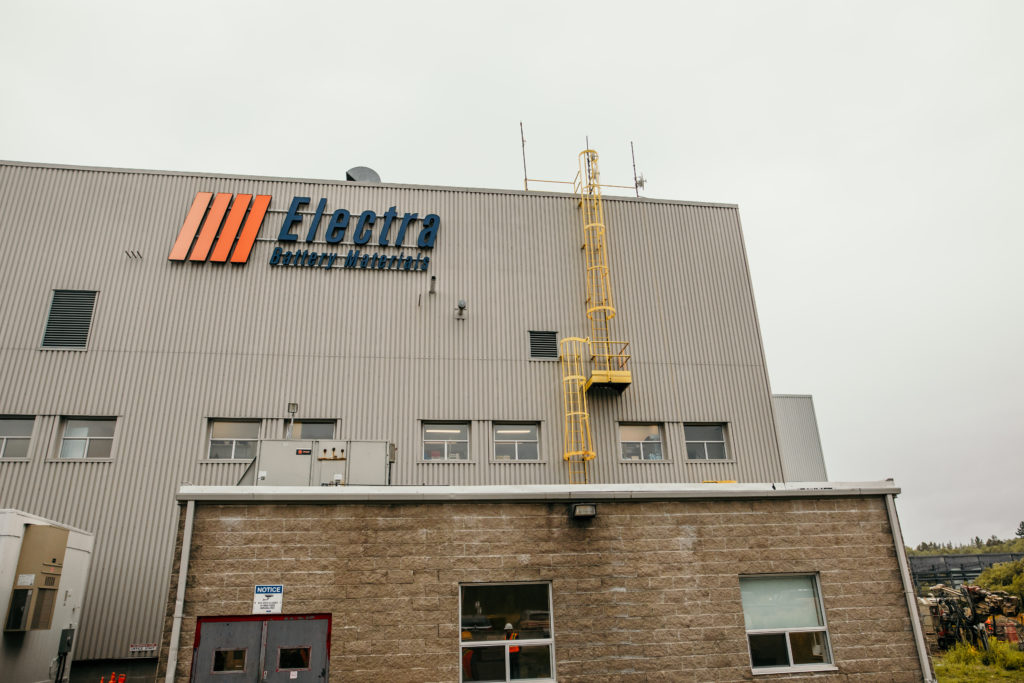Updates on critical mining in northern Ontario
When George Pirie, Ontario’s mines minister, closes his eyes and imagines what a resurgent northern Ontario mining industry will look like five years from now, he might see new nickel mines in Sudbury and Timmins, a battery industrial park in Cobalt, haul trucks transporting nickel concentrate on the recently completed road from the Ring of Fire, and multiple lithium mines and processing facilities in northwestern Ontario.

The northern Ontario mining industry is destined to play an important role in the province’s critical minerals strategy as a supplier of nickel, cobalt, and lithium to southern Ontario’s auto industry.
It is a good bet that much of the scenario will indeed materialize. The drills are confirming that the resources are there, the environmental assessments are progressing, and meetings with battery manufacturers and the automobile industry are resulting in offtake agreements.

The northern Ontario mining industry is destined to play an important role in the province’s critical minerals strategy as a supplier of nickel, cobalt, and lithium to southern Ontario’s auto industry.
“The demand for critical minerals is an enormous opportunity for Ontario to reassert its position in the global mining industry,” said Stephen Flewelling, CEO of Ring of Fire Metals, the Wyloo Metals spinoff now in control of the long-delayed Eagle’s Nest nickel project. “We have slipped. Thirty years ago, Canada was the number one or number two nickel producer in the world. We now have a glorious opportunity to reassert our position, but we must get something significant done within a five-year window or we are going to miss the boat,” he warned. “The world will move on without us and we will be sitting here saying it is too bad.”
Australia-based Wyloo Metals acquired Noront Resources and its extensive Ring of Fire properties 500 km northeast of Thunder Bay in April 2022 for $616.9 million following a long-drawn-out bidding war with BHP. However, it will not be able to start construction without an access road currently undergoing an environmental assessment overseen by the Webiquie and Marten Falls First Nations.
“We believe that the Ring of Fire with respect to further nickel deposits is as prospective as Sudbury,” said Flewelling. “I know because I used to manage the mines in Sudbury for Falconbridge. It will not happen in the Ring of Fire overnight, but we believe there are many more nickel mines in the region beyond Eagle’s Nest.”
Flewelling acknowledges the environmental sensitivity of the region and has committed to limiting the footprint of the operation to 2.0 km2 recycling water and eliminating surface storage of tailings by returning them underground. “We expect that any future developments by us will be similarly responsible,” he said.
The jury is still out on something significant happening in the Ring of Fire within Flewelling’s five-year window, but nickel developments in established mining camps like Sudbury and Timmins face far fewer challenges.
Sudbury
Nickel
In October of last year, for example, Vale celebrated the completion of a $945 million refurbishment and expansion of its Copper Cliff mine complex that will almost double ore production from the site, adding 10,000 tonnes of contained nickel and 13,000 tonnes of copper per year. And in November, it signed a long-term offtake agreement with General Motors to supply battery grade nickel sulphate from its Sudbury, Thompson, and Voisey’s Bay mines.
Glencore’s Sudbury integrated nickel operations is scheduled to complete construction of its $1.3 billion Onaping Depth project in 2025, Magna Mining is optimistic that it can put its recently acquired Denison project (the former Crean Hill mine) in production by the end of this year, and DMC Mining Services, a subsidiary of KGHM International, recently completed the installation of a headframe at the Victoria project 35 km west of Sudbury.
In Timmins, Canada Nickel is targeting to have all its permits in place by mid-2025 for its Crawford project, 40 km north of the city, and to be in production before the end of 2027. An open pit operation, Crawford boasts measured and indicated resources of 1.43 billion tonnes grading 0.24% nickel and an inferred resource of 670 million tonnes grading 0.23% nickel. Estimated production of 50,000 t/y would make Crawford the fifth largest nickel sulphide operation globally, according to the company.
“North American nickel supply and consumption is basically either side of 150,000 tonnes per year, but with what’s happening in the EV market over the next five to 10 years, we are looking at going from 150,000 tonnes to 400,000 to 500,000 tonnes per year,” said Mark Selby, Canada Nickel’s chairman and CEO.
A feasibility study scheduled to be released before the end of June will take into consideration considerable savings from refundable tax credits made possible by the company’s ground-breaking “In-Process Tailings Carbonation” process, which will capture and store an estimated one million tonnes of CO2 per year, positioning Crawford as a case study in how critical minerals are developed in Ontario.
Canada Nickel has also been busy acquiring other properties in the Timmins area, including the past producing Texmont property, 36 km south of the city, to begin supplying the market in the near term. “In the last set of meetings that we had with precursor cathode and battery producers in Korea a month or so ago, we mentioned that we might be able to have a source of nickel by 2025, and they almost leapt out of their chairs,” said Selby, “Right now, battery manufacturers are focused on getting nickel in any way, shape, or form, but close behind that there is the environmental issue,” giving Ontario’s sulphide nickel a clear advantage over the “massive carbon footprint” associated with Indonesia’s laterite resources.
Lithium
Northern Ontario has not historically seen any mining of lithium, but long ignored deposits of lithium bearing pegmatites in the northwest are now being targeted by several exploration companies. Australia-based Green Technology Metals, for example, hopes to begin producing lithium from its 100%-owned Seymour project near Armstrong, 250-km northeast of Thunder Bay, by the first quarter of 2024. The property has an estimated resource of 9.9 million tonnes of lithium oxide grading 1.04%. Other lithium properties in its portfolio include Root, 300-km northwest of Thunder Bay, and Wisa, 100-km east of Fort Frances.
Green Technology Metals has strategic partnerships with Primero, an Australia-based EPC company, and Vancouver-based Lithium Americas, providing it with the technical support to turn lithium concentrate into battery grade lithium hydroxide at a proposed processing plant in Thunder Bay. Lithium Americas is advancing the Thacker Pass lithium mine in Nevada and the Cauchari-Olaroz brine operation in Argentina.
Elsewhere in the northwest, Avalon Advanced Materials has a non-binding memorandum of understanding to supply Korea’s LG Energy Solution with battery-grade lithium hydroxide from its Separation Rapids deposit near Kenora by 2025, Sudbury-based Frontier Lithium’s PAK project 175 km north of Red Lake boasts a measured and indicated resources of 21.64 million tonnes grading 1.56% lithium oxide, and Rock Tech Lithium hopes to be in production late this year or early 2024 at its Georgia Lake property between Beardmore and Nipigon.
Avalon Advanced Materials is also hoping to establish a processing facility in Thunder Bay, while Rock Tech has an offtake agreement with Mercedes Benz and plans to ship crushed material to a proposed company-owned and operated refining facility in Germany.
Cobalt
Northern Ontario also produces some cobalt from polymetallic deposits in Sudbury, but close to 70% of this critical mineral comes from the Democratic Republic of Congo (DRC), most of which is refined in China. That will change this year when a long-mothballed refinery currently undergoing refurbishment and expansion by Electra Battery Materials in the town of Cobalt will become the only North American supplier of cobalt sulphide.
Electra Battery Materials has a contract to import cobalt hydroxide from the DRC and an offtake agreement with LG Energy Solution for 60% of the company’s production over the initial three years of operation. The refinery is currently rated to produce 5,000 tonnes of cobalt sulphide per year but could ramp up to 6,500 tonnes.

The U.S. Inflation Reduction Act (IRA), which offers American consumers a $7,500 credit when they purchase a battery-electric vehicle “really put the wind in our sails,” said Trent Mell, CEO of Electra Battery Materials. “If you have any critical minerals being processed in China, that credit goes to zero, so that is a pretty blunt instrument to encourage onshoring by companies like us.”
“The get out of China rule is what is really driving some of our most recent conversations with OEMs and battery makers,” he added. “All of a sudden, there is this new urgency to get it done.”
But Electra Battery Materials has far more ambitious goals. It is also gearing up to establish a battery recycling plant to process so-called “black mass material” – ground up batteries containing nickel, cobalt, lithium, copper, and graphite – and envisions a battery materials industrial park including a precursor cathode active material (pCAM) plant. “In an ideal world, you would have the cobalt, nickel, and manganese being refined in one location and right next to it, you would have a precursor manufacturer,” said Mell. “It would eliminate a step on both sides. We would no longer have to take the cobalt from solution and crystallize it. We would just pipe it in solution, saving both capex and opex. We will be talking to some of the biggest pCAM companies in the world to interest them in colocating with us.”
Ontario mines minister, George Pirie, who has an extensive background in the mining industry with Noranda and Placer Dome, is optimistic about the ultimate success of Ontario’s critical minerals strategy, telling the Canadian Mining Journal, “We have the world class miners, engineers, and technical people, excellent relations with our Indigenous communities, and we are looking at every aspect of the Mining Act to ensure that these projects get permitted quickly.”
Norm Tollinsky is the former editor of Sudbury Mining Solutions Journal.
Comments
Adrien Legault
Made a deal in Milner to, past producers I was wondering if they will concentrate on the gowganda properties